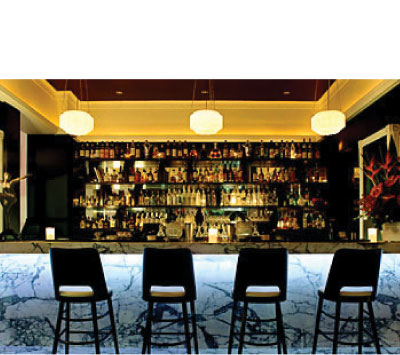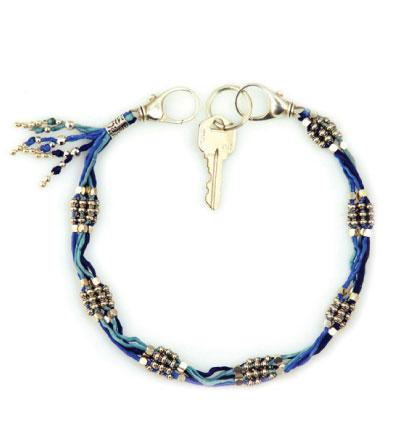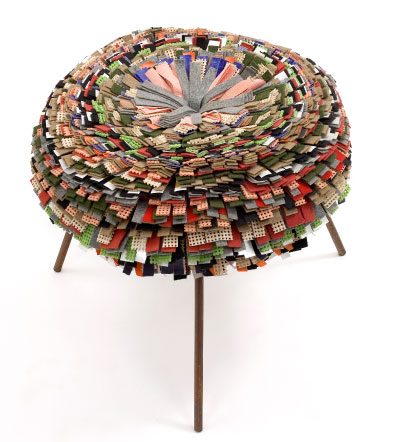
Stool, Pom Pom, 2002. Photography by Fernando Laszlo. All Images © Estudio Campana

For Fernando and Humberto Campana, economic necessity turned into a creative blessing early on in their career. By celebrating the materials that the rest of us discard — such as scraps of fabric, plastic hoses, or carpet padding — they invented a vibrant, energetic and definitively Brazilian approach to design. Fast forward twenty years, and they’re considered two of the most significant designers in today’s Latin America and still going strong, collaborating on projects both large and small. While many of the Campana’s creations are for international manufacturers of furniture, lighting and home accessories, the majority of the work coming out of their São Paulo studio consists of custom-made designs. These one-off objects for the home display the brothers’ playful sense of humor, their clever combinations of materials and a vibrant palette that comes straight from sunny Brazil. For instance, random bits of wood they found on the street make up their Favela Chair, their Sushi Chair is inspired by the patchwork quilts in São Paulo’s slums, and their Vermelha Chair consists of brightly colored cord tied and woven around a metal frame.
(more…)
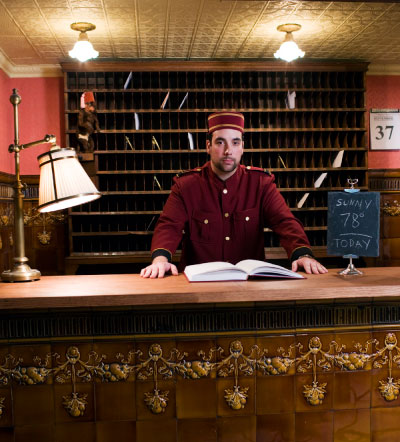
Photography by Gregory Goode

In celebration of youth, oh sweet, flighty and whimsical youth, New York hoteliers Sean MacPherson and Eric Goode of Maritime fame, present their newest venture, the hostel-like Jane Hotel. The landmark building along the Westside Highway was built as a hotel for sailors in 1908. The building’s architect William A. Boring is most famous for designing the Ellis Island immigration station. More fun to note is that in the ‘90s, the hotel ballroom used to hold Hedwig and the Angry Inch shows. Fast-forward and what you have now is a serious renovation and a daring opportunity to make memories. The current Jane hints at fair doses of Darjeeling Limited and The Royal Tenenbaums for inspiration and you get an affordable but incredibly quirky pod hotel featuring nautical cabin rooms for $100 a night with bathrooms down the hall. Room amenities include a compact twin bed with built-in drawers, air conditioning, high-speed Internet access, and flat-screen LCD televisions. Deluxe captains cabins offer queen- and king-sized beds and lovely but limited views of the Hudson. Most coveted is the hotel’s original hand-tiled swimming pool and bathing area. The hotel and lounge have already captured a buzz around town for it’s bohemian allure and relaxed but stylish focus. So whether you’re staying at the hotel, or cruising the city for a drink, stop by for a sit in.
(more…)
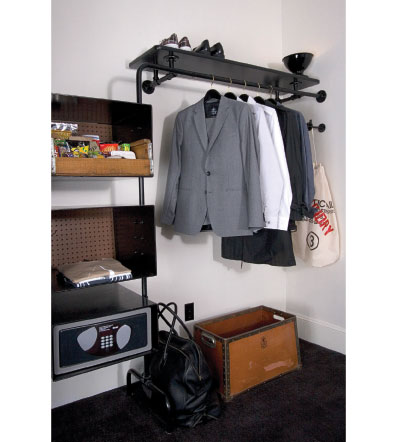
Photography by Jeremy Pelley

Once again, Ace Hotel proves that elegance and simplicity go hand in hand. Similar to their Seattle and Portland locations, Ace Hotel New York offers a wide range of options for the enlightened traveler — everything from bare bones rooms with rates to match up to rockstar suites for those who wish to indulge. All of this comes in a package that’s one part modern and one part traditional, a crossbreed particularly apt for New York City, where opposites collide on a daily basis. Ace Hotel celebrates this wonderful collision and draws on the grit and glamour of New York’s history to make guests feel right at home.
Of course, the masterminds behind Ace don’t just barge into a neighborhood and open up a hotel, rather they note the building’s history — in this case, the former Breslin Hotel, built in 1904 — and observe the local culture as their plan takes shape. This means they’ve maintained the integrity of the original building whenever possible. This comprehensive approach applies to not just the décor and types of rooms; it also influences the way Ace collaborates with local designers, artists, and independent businesses.
(more…)

“Give me the luxuries of life, and I will gladly do without the necessities,” said Frank Lloyd Wright. These words aptly sum up the Lincoln, a den of luxury and comfort housed in a former strip club. The neighborhood of King’s Cross, traditionally Sydney’s red light district, has gone upscale, and the Lincoln, which was re-done last year, can take a lion’s share of the credit. The joint is three levels of decadence, from the basement’s NYC-style club — Prince’s former DJ Ricky Albert is a resident — to the deck bar which has the feel of a 1930s ocean liner. Don’t forget the restaurant, manned by ex-Bibendum chef Richard Duff, with its exclusive Krug room. The Art Deco décor works to create a special environ with the octagon-shaped dining room, the black and gold color scheme, the Calcutta marble bar, and the black timber floors. The joint is spacious, inviting, and diverse. True, you can’t get a lap dance anymore, but if you’re lucky you can get much more.
36 Bayswater Road +02 9331 2311
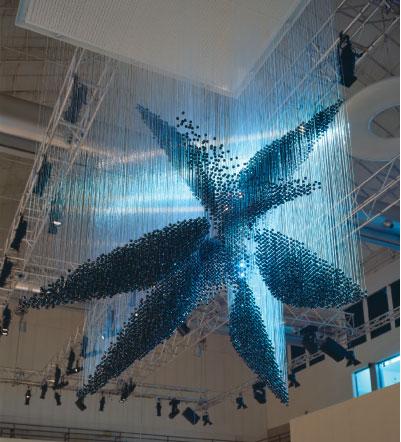
Photography Courtesy of Established & Sons

The Swarm Chandelier is just another example of Zaha Hadid’s genius. Once again the Iraqi-born, London-based architect pushes the boundaries with a piece that defies convention. This time she’s created a chandelier that isn’t technically a chandelier — it has no internal light source — but more of a hanging sculpture. Her Swarm Chandelier, limited to an edititon of eight, resembles a flock of birds or a swarm of insects moving together yet separately. It seems to capture their busy motion in a snapshot, suspended in midair. This still sense of transience is achieved with 16,000 suspended black crystals, each strung by hand on individual wires. The subtle interplay of light reflected on the crystals makes this chandelier come alive, like a hive bustling with activity. Always inventive, Hadid’s designs race on ahead of the pack, surprising us with their extraordinary beauty.

Photography by Eric Heranval

Skate Study House seamlessly blends a passion for mid-century design, skateboard culture, and California lifestyle. Taking its name from the Case Study Houses built mostly in the Los Angeles area from 1945-1966, its furniture designs immediately bring to mind the work of Charles and Ray Eames. However these 21st-century pieces come with a catch: they’re made out of skate decks. Designed and handcrafted in California, Gil Le Bon De Lapointe and Pierre Andre Senizergues’s products use recycled and second hand products mixed with custom parts. Sometimes skate decks are stacked to form the base of a table, while other pieces use them as the planks in a chair; it’s amazing how utilitarian a wooden skate deck can be. Now with a showroom in both Newport Beach and LA’s Echo Park, the word has spread.

Lara Kurtzman, a New York-based jewelry designer, is a fan of accessories that serve many functions. Her signature silk keychain is a perfect example. Made of sterling silver and hand-dyed, hand-rolled silk, it looks equally gorgeous looping out of one’s pocket as it does wrapped around your wrist or even worn as a necklace. Blending elements of European, African, and Asian design, it has a decidedly international aesthetic without losing any rock and roll cred. For hipsters who want to upgrade their look, this is the perfect way to go. You can check out Kurtzman’s jewelry line, KELACALA Q, at kelacalaq.com.
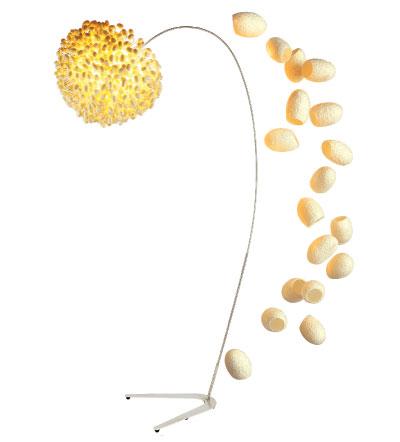
Photography Courtesy of FordBrady

Osisu’s Chairwalker looks like it’s poised for a stealthy exit. With none of its legs at 90-degree angles, it looks like a chair in motion — ready to escape the awkward party or boring meeting. A few years ago, bicyclist and co-founder of VeloAsia Willard Ford had just finished leading a cycling tour through Vietnam and was killing some time in Bangkok when he first set eyes on Osisu’s masterpiece. “I wondered why I had never seen this in the States,” he explains, and in one glance, the idea for the FordBrady Gallery was born.
Upon his return to Los Angeles, Ford enlisted his longtime friend John Brady, and by 2006, the gallery was showcasing some of the most innovative contemporary furniture designers from around the world. Boasting a roster of acclaimed and emerging designers such as the U.K.’s Angus Hutcheson, Thailand’s Chlaphun Chulanond, and Switzerland’s Greenform collective, the gallery takes a global approach to the world of interiors. Ford and Brady travel to Asia at least twice a year and regularly comb the US, Europe, and South America for new work. With one eye on craftsmanship and the other on sustainability, good design is a language we can all understand.
fordbrady.com
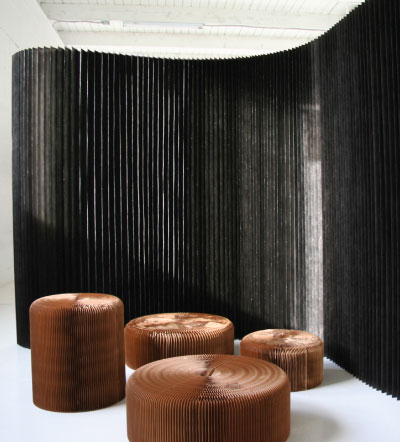
Molo

Less is more. How can three abusively clichéd words be used as a conceptual premise for everything from sustainable architecture to avant-garde design? For the last four years, Canada’s Stephanie Forsythe, Todd MacAllen, and Robert Pasut have been illuminating the downstage of modern design with their Vancouver-based lovechild, Molo Design, proving that minimalism and conceptuality can play nice. Molo, a multidisciplinary design platform with a concentration on materials and creative space-manipulation, is a workshop of “critique and compromise”. Since 2003, the Molo trio has been delivering the goods by constantly fluxing and fusing the designers’ perspectives. From tubular champagne flutes that make cocktails look like they’re floating in midair to sculptural rock formations made with industrial byproducts, their award-winning designs have made significant ripples on a sea of minimalism. (more…)





 Facebook
Facebook Permalink
Permalink Digg
Digg Reddit
Reddit LinkedIn
LinkedIn StumbleUpon
StumbleUpon Tumblr
Tumblr


